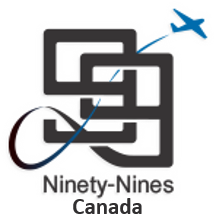D A P H N E P A T E R S O N was another of our earliest Pioneer women pilots. She obtained her Pilot’s Licence in 1929, one year later than Eileen Vollick who was Canada’s FIRST woman pilot. Daphne was the first woman to be licensed in the Province of New Brunswick. Although she was not well known in the annals of aviation history she was a very determined, ambitious young lady who excelled at flying and earned the respect of everyone she came into contact with.
The daughter of Dr. and Mrs A.P. Paterson, she was born in St. John in 1905 and graduated from McGill University in Montreal with a Batchelor of Science degree. Engines, whether in cars or planes, fascinated her. Daphne raced cars and held a speed record between
St. John and Montreal, a distance of 800 miles. It was inevitable that she eventually became interested in flying.
On her very first flight, the Chief Flying Instructor at the Montreal Light Aeroplane Club, tried to discourage her by flying aerobatic manoeuvres. He was not amused when she came back for another lesson the next day. (Most men were very negative in those years about women venturing into their domain of flight!)
Daphne joined the Montreal Light Aeroplane Club in 1929 and luckily found an Instructor who encouraged her to attain her Pilot’s Licence. She began her dual instruction with H. “Tony” Spooner on February 2, 1929. A “natural” pilot, she was allowed to go solo after only 7 hours and 10 minutes flying time. On May 29, 1929, she passed her flying tests before Inspector Stuart Graham and received her Private Pilot’s Certificate No. 327.
She continued her flight training and on March 15, 1930, she became the FIRST woman in Canada to qualify for her Commercial Pilot’s Licence, Certificate #658. The Department of National Defence, who granted all licences, first rejected her application, solely because she was female!
Her Instructor, Tony Spooner, who had been her biggest supporter from the beginning, challenged the powers that be, that the word “PILOT” in Regulations, did not specify MALE ONLY! However, due to the fact that she would be the first woman Commercial Pilot, they panicked and introduced a brand new rule requiring a medical every three months instead of the current six months for a male Commercial Pilot. (They hadn’t considered the possibility of a pregnant Commercial pilot before!)
Daphne was very well known as a pilot in eastern Canada. An active member of Flying Clubs in Montreal, St. John, the Fredericton Flying Club and the Toronto Flying Club, she was always a very strong supporter of general aviation. She became involved in many flying activities to educate the general public and also spread the word that women could make flying a career. She generated a lot of press in the media, but the Airlines were not considering hiring females under any circumstances, no matter how qualified they were.
In 1931, she won the Canadian Flying Clubs’ de Havilland Trophy in Class “A” in the Maritime zone competitions and was a runner-up twice in the Canadian Webster Trophy Trials. She crossed many hurdles in those early days, meeting male resistance at every step of her flying achievements, but she never considered giving up at that time.
Daphne married Tony Shelfoon in the mid-thirties, a pilot who was working towards a career in aviation. ( He eventually became a Squadron Leader in the RCAF) Daphne kept her flying current and a few years later, earned a Public Transport Licence, Certificate #130 on August 9, 1938. The highest rating possible in Canada. The three-month medical was once again a requirement for this Licence. She was the only woman to hold a Public Transport Licence in Canada prior to World War II. She felt she must be well qualified to fly in the RCAF when and if war was declared. At some point, there was a strong possibility, that owing to a shortage of instructors, she might pursue her ambition in this way, so she began training for her Instructor’s Licence, receiving it in May, 1940.
It was all to no avail, when it came down to the crunch, she was told that they felt it was improper for women to teach men how to fly! By then, she was considered too old to join the Air Transport Auxilliary. In desperation, she contacted Jacqueline Cochran who was recruiting for the newly formed Womens Air Force Service Pilots (WASPS) but she didn’t have the required American citizenship to qualify. She had exhausted all possible leads and no one would hire her.
Daphne Paterson ultimately spent the war years on the ground as a journalist. By the time the flying clubs suspended operations, she had a total of 410 hard-earned flying hours and every rating possible in her log book. She gave up flying when she moved to Trenton with her husband after the war. There was no civil airfield in the area at that time.
In 1978, the First Canadian Chapter of the 99s, honoured her with the presentation of an Amelia Earhart Medallion at a small dinner party in Toronto. Daphne was too shy to attend a large Section Meeting of the 99s, but representatives from all East Canada Section Chapters were invited to the dinner. A delightful lady, it was a privilege to have met her. Daphne passed away in Trenton, March 1982, at the age of 77.
Daphne Paterson and others like her had the courage, skill and determination to follow their dreams, even though due to prejudices, they sometimes didn’t attain their ultimate goals. We owe many of our present flying privileges to these Pioneer ladies.


